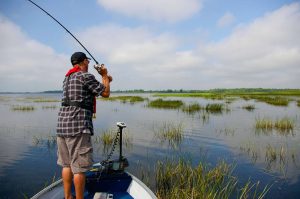Trolling for bass is a time-tested technique that continues to captivate anglers of all skill levels. With the right approach, trolling can yield impressive catches, especially when targeting largemouth and smallmouth bass. Whether you’re a seasoned pro or a novice, this guide will help you understand the essentials of trolling for bass, a technique that’s particularly effective during the warmer months when bass are on the move.
Why Trolling Works for Bass
Trolling is an excellent method for covering large areas of water, making it ideal for locating active bass. Unlike stationary fishing, trolling allows you to present your bait at various depths and speeds, increasing your chances of finding where the fish are biting.
Key Trolling Techniques
- Speed Control: The speed at which you troll plays a significant role in your success. Slow trolling (1.5 to 2.5 mph) is often effective for bass, as it allows your lure to move naturally through the water, mimicking the movement of prey.
- Depth Targeting: Bass often stay at specific depths depending on the time of year, water temperature, and time of day. Using downriggers or lead core lines can help maintain your lure at the optimal depth. In the summer, bass may move deeper to stay cool, so trolling at depths of 15 to 25 feet might be necessary.
- Lure Selection: The right lure can make all the difference when trolling for bass. Crankbaits, spinnerbaits, and soft plastic swimbaits are popular choices. Choose a lure that matches the size and color of the local baitfish. Experiment with different lures until you find what the bass are biting on that day.
- Line Management: Keep an eye on your line for any signs of a bite, such as a sudden tug or change in tension. Using a line counter reel can help you monitor how much line you have out, ensuring your lure stays at the desired depth.

When and Where to Troll for Bass
- Seasonal Timing: Trolling for bass is most effective during the late spring, summer, and early fall when bass are actively feeding. During these months, bass are more likely to chase down a moving lure, making trolling a viable option.
- Best Locations: Focus on areas with structure, such as submerged logs, rock piles, and weed beds, where bass are likely to hide. In larger lakes, trolling along drop-offs, ledges, and channels can also yield results.
- Weather Considerations: Overcast days with a slight breeze can create ideal trolling conditions, as bass are more likely to be near the surface. On sunny days, you may need to troll deeper to find bass hiding from the heat.
Advanced Trolling Tips
- Use Multiple Lines: Running multiple lines at different depths and with different lures can increase your chances of success. Just be mindful of potential tangles, especially when making turns.
- Stay Versatile: If you’re not getting bites, don’t be afraid to change your trolling speed, depth, or lure. Bass can be finicky, and what worked yesterday might not work today.
- Pay Attention to the Bite: When you get a bite, note the depth, speed, and lure used. This information can help you replicate the conditions that led to success.
- Maintain Steady Pressure: Once you hook a bass, keep steady pressure on the line to prevent it from shaking the hook. Avoid jerking the rod, which could cause the hook to come loose.
The Thrill of Trolling for Bass
Trolling for bass offers a dynamic and engaging way to fish, combining elements of strategy, skill, and patience. It’s a method that rewards experimentation and adaptability, making every trip an opportunity to learn and improve. Whether you’re targeting trophy-sized bass or just enjoying a day on the water, trolling is a technique that can deliver exciting results. So next time you hit the lake, consider giving trolling a try—you might just hook the bass of a lifetime.
Image: anglerwise





